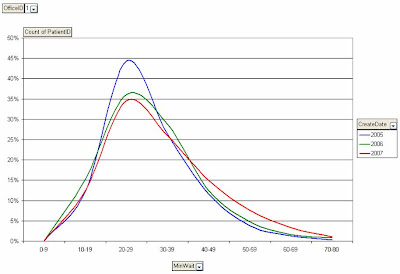Here is one answer. Assume that you’re family doctor with 15 minute appointments. In a 4 hour chunk of time you have 16 people booked. Everyone arrives early enough for your administrative staff to register them (2.5min), the nurse to update their medical history (3min), you spend exactly 15minutes with them and the front desk checks them out and arranges the next appointment (5min). Life is perfect and no one waits in the office.
Variation
The reality, as any health care provider realizes, is that nothing goes so smoothly. Variation in the number of people seen, the time people arrive at and the time it takes in each step causes the process to go faster or slower. The good news is that EMR and process simulators allow us to measure, analyze and replicate a standard day and look for improvements.
To decrease the total time a process requires the average time and the amount of variation must be contorl. The effect is about 75%:25% on the total time. The notation I’ll use is mean time (or patients) +/- standard deviation assuming that the number of people arriving and the variation in the time of each step is a normal distribution.
More Realistic Numbers
Let’s look at the scenario again.
Number of Patients 16 +/- 3
Arrival Time 15min +/- 5
Registration 2.5min +/- 1.5
Update Medical History 3min +/- 2
Examination 15min +/- 7.5
Administration after Exam 5.6min +/- 2.4
With 1 minute to move between each step

The Answer
I then run this scenario for a 4-hour block and replicate it 20 times to calculate an average:
The team will run over by 20 minutes on average (4.3 hours)
The average time in the office for the patient is 44 minutes
Time average time spent doing nothing (waiting) is 14 minutes. In this case the doctor had high variation (50%) so most waiting was done waiting for the doctor.
Discussion
I’d previously said that our office strives to get people in and out within 50minutes (and the typical consult is 15minutes) so this seems intuitively correct. If the numbers are increased to one patient every 30 minutes (8 +/- 2 patients in 4 hours) and the variation remains the same the average time in the office is 49 minutes. The longer the appointment the less significant the natural variation is and the more predictable the time should be. The simulations can be run for any type of scenario and are useful for bench marking performance and finding problem spots. There is no single answer to how long one should wait in the doctor’s office. It depends on the emergency volume, after length of the appointment and how much slack is in the system.
Where to Start
If you're a doctor with a problem start by measuring how long people spend in your office for a standard length of appointment. If people spend and average of 45 minutes there for a 15 minute appointment it's within reason. If it's an hour and 45 minutes you have a problem.







No comments:
Post a Comment